Micromorphology, Ultrastructure and Histochemistry of Commelina benghalensis L. Leaves and Stems
Abstract
1. Introduction
2. Materials and Methods
2.1. Plant Material Collection
2.2. Stereomicroscopy
2.3. Scanning Electron Microscopy (SEM)
2.4. Transmission Electron Microscopy (TEM)
2.5. Histochemistry
3. Results and Discussion
3.1. Stereomicroscopy of Leaves and Stem of C. benghalensis
3.2. Scanning Electron Microscopy of Leaves and Stems of C. benghalensis
3.3. Survey Sections of Leaves and Stem of C. benghalensis Embedded in Resin
3.4. Ultrastructural Analysis Using Transmission Electron Microscopy
3.5. Localisation of Bioactive Compounds within Trichomes of C. benghalensis
4. Conclusions
Author Contributions
Funding
Institutional Review Board Statement
Informed Consent Statement
Data Availability Statement
Acknowledgments
Conflicts of Interest
References
- Hossain, F.; Saha, S.; Islam, M.M.; Nasrin, S.; Adhikari, S. Analgesic and anti-inflammatory activity of Commelina benghalensis Linn. Turk. J. Pharm. Sci. 2014, 11, 25–32. [Google Scholar]
- Mbazima, V.G.; Mokgotho, M.P.; February, F.; Rees, D.J.G.; Mampuru, L.J. Alteration of Bax-to-Bcl-2 ratio modulates the anticancer activity of methanolic extract of Commelina benghalensis (Commelinaceae) in Jurkat T cells. Afr. J. Biotechnol. 2008, 7, 3569–3576. [Google Scholar]
- Foden, W.; Potter, L. Commelina benghalensis L. South African National Biodiversity Institute (SANBI) National Assessment: Red List of South African Plants Version 2017.1. 2005. Available online: http://redlist.sanbi.org/species.php?species=3576-13 (accessed on 1 March 2021).
- Webster, T.M.; Burton, M.G.; Culpepper, A.S.; York, A.C.; Prostko, E.P. Tropical spiderwort (Commelina benghalensis): A tropical invader threatens agroecosystems of the southern United States. Weed Technol. 2005, 19, 501–508. [Google Scholar] [CrossRef]
- Ghosh, P.; Dutta, A.; Biswas, M.; Biswas, S.; Hazra, L.; Nag, S.K.; Sil, S.; Chatterjee, S. Phytomorphological, chemical and pharmacological discussions about Commelina benghalensis Linn. (Commelinaceae): A review. Pharma Innov. 2019, 8, 12–18. [Google Scholar]
- Chhabara, S.C.; Mahunnah, R.L.A.; Mshiu, E.N. Plants used in traditional medicine in Eastern Tanzania. Ii. Angiosperms (Capparidaceae to Ebenaceae). J. Ethnopharmacol. 1989, 25, 339–359. [Google Scholar] [CrossRef]
- Steenkamp, V. Traditional herbal remedies used by South African women for gynaecological complaints. J. Ethnopharmacol. 2003, 86, 97–108. [Google Scholar] [CrossRef]
- Yetein, M.H.; Houessou, L.G.; Lougbégnon, T.O.; Teka, O.; Tente, B. Ethnobotanical study of medicinal plants used for the treatment of malaria in plateau of Allada, Benin (West Africa). J. Ethnopharmacol. 2013, 146, 154–163. [Google Scholar] [CrossRef]
- Nair, R.; Kalariya, T.; Chanda, S. Antibacterial activity of some plant extracts used in folk medicine. J. Herb. Pharm. 2007, 7, 3–4. [Google Scholar] [CrossRef]
- Khan, M.A.A.; Islam, M.T.; Rahman, M.A.; Ahsan, Q. Antibacterial activity of different fractions of Commelina benghalensis L. Der Pharmacia Sinica 2011, 2, 320–326. [Google Scholar]
- Sarkar, M.R.; Chowdhury, A.R.; Ganguly, A.; Momen, A.Z.M.R. Evaluation of antinociceptive and antidiarrheal activities of Commelina benghalensis herbs in albino mice. Jagannath Univ. J. Sci. 2014, 3, 50–56. [Google Scholar]
- Gurjar, H.P.S.; Irchhaiya, R.; Verma, A. Antidiabetic activity and phytochemical investigation on the whole plant of Commelina benghalensis Linn. in male albino rat. J. Drug Deliv. Ther. 2016, 6, 26–29. [Google Scholar] [CrossRef]
- Kansagara, P.; Pandya, D.J. A complete review on medicinally active herbal weed: Commelina benghalensis L. (Commelinaceae). J. Pharm. Sci. Res. 2019, 11, 1165–1171. [Google Scholar]
- Edeoga, H.O.; Okwu, D.E.; Mbaebie, B.O. Phytochemical constituents of some Nigerian medicinal plants. Afr. J. Biotechnol. 2005, 4, 685–688. [Google Scholar] [CrossRef]
- Fahn, A. Secretory tissues in vascular plants. New Phytol. 1988, 108, 229–257. [Google Scholar] [CrossRef]
- Tissier, A. Plant secretory structures: More than just reaction bags. Curr. Opin. Biotechnol. 2018, 49, 73–79. [Google Scholar] [CrossRef]
- Werker, E. Trichome diversity and development. Adv. Bot. Res. 2000, 31, 1–35. [Google Scholar]
- Schilmiller, A.L.; Last, R.L.; Pichersky, E. Harnessing plant trichome biochemistry for the production of useful compounds. Plant. J. 2008, 54, 702–711. [Google Scholar] [CrossRef]
- Wagner, G.J.; Wang, E.; Shepherd, R.W. New approaches for studying and exploiting an old protuberance, the plant trichome. Ann. Bot. 2004, 93, 3–11. [Google Scholar] [CrossRef]
- De Andrade Wagner, M.; Loeuille, B.F.P.; Siniscalchi, C.M.; Melo-de-Pinna, F.; Pirani, J.R. Diversity of non-glandular trichomes in subtribe Lychnophorinae (Asteraceae: Vernonieae) and taxonomic implications. Plant Syst. Evol. 2014, 300, 1219–1233. [Google Scholar] [CrossRef]
- Stratmann, J.W.; Bequette, C.J. Hairless but no longer clueless: Understanding glandular trichome development. J. Exp. Bot. 2016, 67, 5285–5287. [Google Scholar] [CrossRef]
- Kibiti, C.M.; Afolayan, A.J. Ultrastructural micromorphology of Bulbine abyssinica a. Rich. growing in the Eastern Cape province, South Africa. Pak. J. Bot. 2015, 47, 1929–1935. [Google Scholar]
- Ferreira, M.; van de Merwe, C.F.; Reinhardt, C.F. Ultrastructural changes caused by post-emergence herbicides in leaves of bengal wandering jew (Commelina benghalensis L.). S. Afr. J. Plant Grond. 1999, 16, 18–23. [Google Scholar] [CrossRef][Green Version]
- Van Bel, A.J.E.; van Kesteren, W.J.P.; Papenhuijzen, C. Ultrastructural indications for coexistence of symplastic and apoplastic phloem loading in Commelina benghensis leaves. Planta 1988, 176, 159–172. [Google Scholar] [CrossRef]
- Vankesteren, W.J.P.; Vanderschoot, C.; van Bel, A.J.E. Symplastic transfer of fluorescent dyes from mesophyll to sieve tube in stripped leaf tissue and partly isolated minor veins of Commelina benghalensis. Plant Physiol. 1988, 88, 667–670. [Google Scholar] [CrossRef] [PubMed][Green Version]
- Spurr, A.R. A low-viscosity epoxy resin embedding medium for electron microscopy. J. Ultrastruct. Res. 1969, 26, 31–43. [Google Scholar] [CrossRef]
- Johansen, D.A. Plant Microtechnique, 1st ed.; McGraw-Hill Book Company, Inc.: New York, NY, USA; London, UK, 1940. [Google Scholar]
- O’Brien, T.P.; Feder, N.; McCully, M.E. Polychromatic staining of plant cell walls by Toluidine Blue O. Protoplasma 1964, 59, 368–373. [Google Scholar] [CrossRef]
- Mitra, P.P.; Loqué, D. Histochemical staining of Arabidopsis thaliana secondary cell wall elements. J. Vis. Exp. 2014, 87, 1–11. [Google Scholar]
- Asghar, K.; Reddy, B.G.; Krishna, G. Histochemical localization of glutathione in tissues. J. Histochem. Cytochem. 1975, 23, 774–779. [Google Scholar] [CrossRef] [PubMed]
- Hughes, J.; McCully, M.E. The use of an optical brightener in the study of plant structure. Stain Technol. 1975, 50, 319–329. [Google Scholar] [CrossRef] [PubMed]
- Kafle, K.; Shi, R.; Lee, C.M.; Mittal, A.; Park, Y.B.; Sun, Y.; Park, S.; Chiang, V.; Kim, S.H. Vibrational sum-frequency-generation (SFG) spectroscopy study of the structural assembly of cellulose microfibrils in reaction woods. Cellulose 2014, 21, 2219–2231. [Google Scholar] [CrossRef]
- Fisher, D.A. Protein staining of ribboned epon sections for light microscopy. Histochemie 1968, 16, 92–96. [Google Scholar] [CrossRef]
- Pearse, A.G.E. Histochemistry, Theoretical and Applied, 4th ed.; Churchill Livingstone: Edinburgh, UK, 1985. [Google Scholar]
- Gahan, P.B. Plant Histochemistry and Cytochemistry. An Introduction; Academic Press: London, UK, 1984. [Google Scholar]
- Fulcher, R.G.; Wong, S.I. Inside cereals—A fluorescence microchemical view. In Cereals for Food and Beverages: Recent Progress in Cereal Chemistry; Inglett, G.E., Munch, L., Eds.; Academic Press: New York, NY, USA, 1980; pp. 1–26. [Google Scholar]
- De Micco, V.; Aronne, G. Combined histochemistry and autofluorescence for identifying lignin distribution in cell walls. Biotech. Histochem. 2007, 82, 209–216. [Google Scholar] [CrossRef] [PubMed]
- Bond, J.; Donaldson, L.; Hill, S.J.; Hitchcock, K. Safranin fluorescent staining of wood cell walls. Biotechn. Histochem. 2008, 83, 161–171. [Google Scholar] [CrossRef]
- Furr, M.; Malhberg, P.G. Histochemical analyses of laticifers and glandular trichomes in Cannabis sativa. J. Nat. Prod. 1981, 44, 153–159. [Google Scholar] [CrossRef]
- Winter, N.; Kollwid, G.; Zhange, S.; Kragler, F. MPB2C, a microtubule-associated protein KNOTTED. Am. Soc. Plant Biol. 2007, 19, 3001–3018. [Google Scholar]
- Tozin, L.R.S.; Silva, C.M.; Rodrigues, T.M. Non-glandular trichomes in Lamiaceae and Verbenaceae species: Morphological and histochemical features indicate more than physical protection. N. Z. J. Bot. 2016, 54, 446–457. [Google Scholar] [CrossRef]
- Johnson, H.B. Plant pubescence: An ecological perspective. Bot. Rev. 1975, 41, 233–258. [Google Scholar] [CrossRef]
- Ascensão, L.; Pais, M.S.S. Glandular trichomes of Artemisia campestris (ssp. Maritima): Ontogeny and histochemistry of the secretory product. Bot. Gaz. 1987, 148, 221–227. [Google Scholar] [CrossRef]
- Gairola, S.; Naidoo, Y.; Bhatt, A.; Nicholas, A. An investigation of the foliar trichomes of Tetradenia riparia (Hochst.) Codd [Lamiaceae]: An important medicinal plant of Southern Africa. Flora 2009, 204, 325–330. [Google Scholar] [CrossRef]
- Munien, P.; Naidoo, Y.; Naidoo, G. Micromorphology, histochemistry and ultrastructure of the foliar trichomes of Withania somnifera (L.) Dunal (Solanaceae). Planta 2015, 242, 1107–1122. [Google Scholar] [CrossRef]
- Levin, D.A. The role of trichomes in plant defense. Q. Rev. Biol. 1973, 48, 3–15. [Google Scholar] [CrossRef]
- Dalin, P.A.; Björkman, C.; Huttunen, P.; Kärkkäinen, K. Leaf trichome formation and plant resistance to herbivory. In Induced Plant Resistance to Herbivory; Schaller, A., Ed.; Springer: Dordrecht, The Netherlands, 2008; pp. 89–105. [Google Scholar]
- Szyndler, M.W.; Haynes, K.F.; Potter, M.F.; Corn, R.M.; Loudon, C. Entrapment of bed bugs by leaf trichomes inspires microfabrication of biomimetic surfaces. J. R. Soc. Interface 2013, 10, 1–9. [Google Scholar] [CrossRef] [PubMed]
- Hauser, M. Molecular basis of natural variation and environmental control of trichome patterning. Front. Plant Sci. 2014, 5, 1–7. [Google Scholar] [CrossRef]
- Faden, R.B. Commelinaceae, Flowering Plants—Monocotyledons. In The Families and Genera of Vascular Plants; Kubitzki, K., Ed.; Springer: Heidelberg/Berlin, Germany, 1998; pp. 109–128. [Google Scholar]
- Payne, W.W. A glossary of plant hair terminology. Brittonia 1978, 30, 239–255. [Google Scholar] [CrossRef]
- Santos, I.C.; Meira, R.M.S.A.; Ferreira, F.A.; Santos, L.D.T.; Miranda, G.V. Anatomical features of two Dayflower species (Commelina spp.) on glyphosate efficacy. Planta Daninha 2002, 20, 1–8. [Google Scholar] [CrossRef]
- Oladipo, O.T.; Ayo-Ayinde, M.A. Foliar epidermal morphology of the genera Aneilema and Commelina (Commelinaceae). Ife J. Sci. 2014, 16, 219–224. [Google Scholar]
- Tomlinson, P.B. Anatomical data in the classification of Commelinaceae. Bot. J. Lin. Soc. 1966, 59, 371–395. [Google Scholar] [CrossRef]
- Dute, R.R.; Jackson, B.E.; Adkins, R.D.; Folkerts, D.R. Anatomy of the laminar organs of Commelina erecta (Commelinaceae). Southeast. Nat. 2007, 6, 47–66. [Google Scholar] [CrossRef]
- Choi, J.; Kim, E. Structural features of glandular and non-glandular trichomes in three species of Mentha. Appl. Microsc. 2013, 43, 47–53. [Google Scholar] [CrossRef][Green Version]
- Panneer, J.; Balakrishnan, C.P. Morpho-anatomical and phytochemical studies of Commelina benghalensis L. of Commelinaceae. Int. J. Phytoph. 2015, 6, 143–151. [Google Scholar]
- Schmitz, G.; Muller, G. Structure and function of lamellar bodies, lipid-protein complexes involved in storage and secretion of cellular lipids. J. Lipid Res. 1991, 32, 1539–1570. [Google Scholar] [CrossRef]
- Kühlbrandt, W. Structure and function of mitochondrial membrane protein complexes. BMC Biol. 2015, 13, 1–11. [Google Scholar] [CrossRef]
- Cilia, M.L.; Jackson, D. Plasmodesmata form and function. Curr. Opin. Cell Biol. 2004, 16, 500–506. [Google Scholar] [CrossRef] [PubMed]
- Evert, R.F. The Protoplast: Plasma Membrane, Nucleus, and Cytoplasmic Organelles. In Esau’s Plant Anatomy: Meristems, Cells, and Tissues of the Plant Body: Their Structure, Function, and Development, 3rd ed.; Wiley-Interscience: Hoboken, NJ, USA, 2006; pp. 15–43. [Google Scholar]
- Kessler, F.; Vidi, P. Plastoglobule lipid bodies: Their functions in chloroplasts and their potential for applications. Adv. Biochem. Engin. Biotechnol. 2007, 107, 153–172. [Google Scholar]
- Nakata, P.A. Advances in our understanding of calcium oxalate crystal formation and function in plants. Plant. Sci. 2003, 164, 901–909. [Google Scholar] [CrossRef]
- Schweingruber, F.H.; Börner, A. Structure of the cell wall and cell contents. In the Plant Stem, a Microscopic Aspect; Springer: Cham, Switzerland, 2018; pp. 29–42. [Google Scholar]
- Franceschi, V.R.; Nakata, P.A. Calcium oxalate in plants: Formation and function. Annu. Rev. Plant. Biol. 2005, 56, 41–71. [Google Scholar] [CrossRef]
- Edeoga, H.O.; Ugbo, H.N. Histochemical localization of calcium oxalate crystals in the leaf epidermis of some Commelina L. (Commelinaceae) and its bearing on taxonomy. Acta Phytotax. Geobot. 1997, 48, 23–30. [Google Scholar]
- Yu, H.; Kowalski, S.P.; Steffens, J.C. Comparison of polyphenol oxidase expression in glandular trichomes of Solanum and Lycopersicon species. Plant. Physiol. 1992, 100, 1885–1890. [Google Scholar] [CrossRef]
- Duke, S.O. Glandular trichomes—A focal point of chemical and structural interactions. Int. J. Plant Sci. 1994, 155, 617–620. [Google Scholar] [CrossRef]
- Hartmann, T.; Ober, D. Biosynthesis and metabolism of pyrrolizidine alkaloids in plants and specialized insect herbivores. In Biosynthesis, Topics in Current Chemistry; Leeper, F.J., Vederas, J.C., Eds.; Springer: Berlin, Germany, 2000; pp. 207–243. [Google Scholar]
- Boudet, A.M. Lignins and lignification: Selected issues. Plant Physiol. Biochem. 2000, 38, 81–96. [Google Scholar] [CrossRef]
- Figueiredo, A.C.; Barroso, J.G.; Pedro, L.G.; Scheffer, J.J.C. Factors affecting secondary metabolite production in plants: Volatile components and essential oils. Flavour Fragr. J. 2008, 23, 213–226. [Google Scholar] [CrossRef]
- Moura, J.C.M.S.; Bonine, C.A.V.; Viana, J.O.F.; Dornelas, M.C.; Mazzafera, P. Abiotic and biotic stresses and changes in the lignin content and composition in plants. J. Integr. Plant Biol. 2010, 52, 360–376. [Google Scholar] [CrossRef]
- Mayekiso, B.; Magwa, M.L.; Coopoosamy, R. The morphology and ultrastructure of glandular and non-glandular trichomes of Pteronia incana (Asteraceae). Afr. J. Plant. Sci. 2008, 2, 50–60. [Google Scholar]
- Ibrahim, J.; Ajaegbu, V.C.; Egharevba, H.O. Pharmacognostic and Phytochemical analysis of Commelina benghalensis L. Ethnobot. Leafl. 2010, 14, 10–15. [Google Scholar]
- Ndam, L.M.; Mih, A.M.; Fongod, A.G.N.; Tening, A.S.; Tonjock, R.K.; Enang, J.E.; Fujii, Y. Phytochemical screening of the bioactive compounds in twenty (20) Cameroonian medicinal plants. Int. J. Curr. Microbiol. Appl. Sci. 2014, 3, 768–778. [Google Scholar]
- Hasan, S.M.R.; Hossain, M.M.; Akter, R.; Jamila, M.; Mazumder, M.E.H.; Alam, M.A.; Faruque, A.; Rana, S.; Rahman, S. Analgesic activity of different fractions of the aerial parts of Commelina benghalensis Linn. Int. J. Pharmacol. 2010, 6, 63–67. [Google Scholar] [CrossRef]
- Prakash, N.K.U.; Jahnavi, B.; Abhinaya, K.; Rajalin, A.G.; Babu, H.S.; Kumar, M.P.; Reddy, K.U.; Reddy, K.D.; Sundraraman, G.; Elumalai, K.; et al. Phytochemical analysis of common weeds of northern districts in Tamil Nadu. Int. J. Appl. Biol. 2011, 2, 25–28. [Google Scholar]
- Tadesse, S.; Ganesan, K.; Nair, S.K.P.; Letha, N.; Gani, S.B. Preliminary phytochemical screening of different solvent extracts of leaves and stems of Commelina benghalensis L. (Family: Commelinaceae). Int. J. Pharm. Chem. Biol. Sci 2016, 6, 103–107. [Google Scholar]
- Tiwari, S.K.; Lahkar, M.; Dash, S.; Samudrala, P.K.; Thomas, M.J.; Augustine, B.B. Preliminary phytochemical, toxicity and anti- inflammatory evaluation of Commelina benghalensis. Int. J. Green Pharm. 2013, 7, 201–205. [Google Scholar]
- Omogbehin, S.A.; Umar, S.I.; Olatunji, O. Inhibitive properties of Commelina benghalensis leaves on the corosion of mild steel in 1M HCL. Int. J. Adv. Acad. Res. 2018, 4, 41–48. [Google Scholar]
- Alaba, C.S.M.; Chichioco-Hernandez, C.L. 15-Lipoxygenase inhibition of Commelina benghalensis, Tradescantia fluminensis, Tradescantia zebrina. Asian Pac. J. Trop. Biomed. 2015, 4, 184–188. [Google Scholar] [CrossRef]
- Ghosh, P.; Biswas, S.; Dutta, A.; Biswas, M.; Das, S.; Das, C.; Ghosh, C.; Chatterjee, S. Evaluation of phytochemical constituents and antioxidant property of leaf acetone extracts of five herbaceous medicinal weeds. J. Pharm. Sci. Res. 2019, 11, 2806–2813. [Google Scholar]
- Mukherjee, K.; Ray, L.N. Phytochemical screening of some Indian medicinal plant species part II. Int. J. Crude Drug Res. 1986, 24, 187–205. [Google Scholar] [CrossRef]
- Shitan, N. Secondary metabolites in plants: Transport and self-tolerance mechanisms. Biosci. Biotechnol. Biochem. 2016, 80, 1283–1293. [Google Scholar] [CrossRef] [PubMed]
- Isah, T. Stress and defense responses in plant secondary metabolites production. Biol. Res. 2019, 52, 1–25. [Google Scholar] [CrossRef]
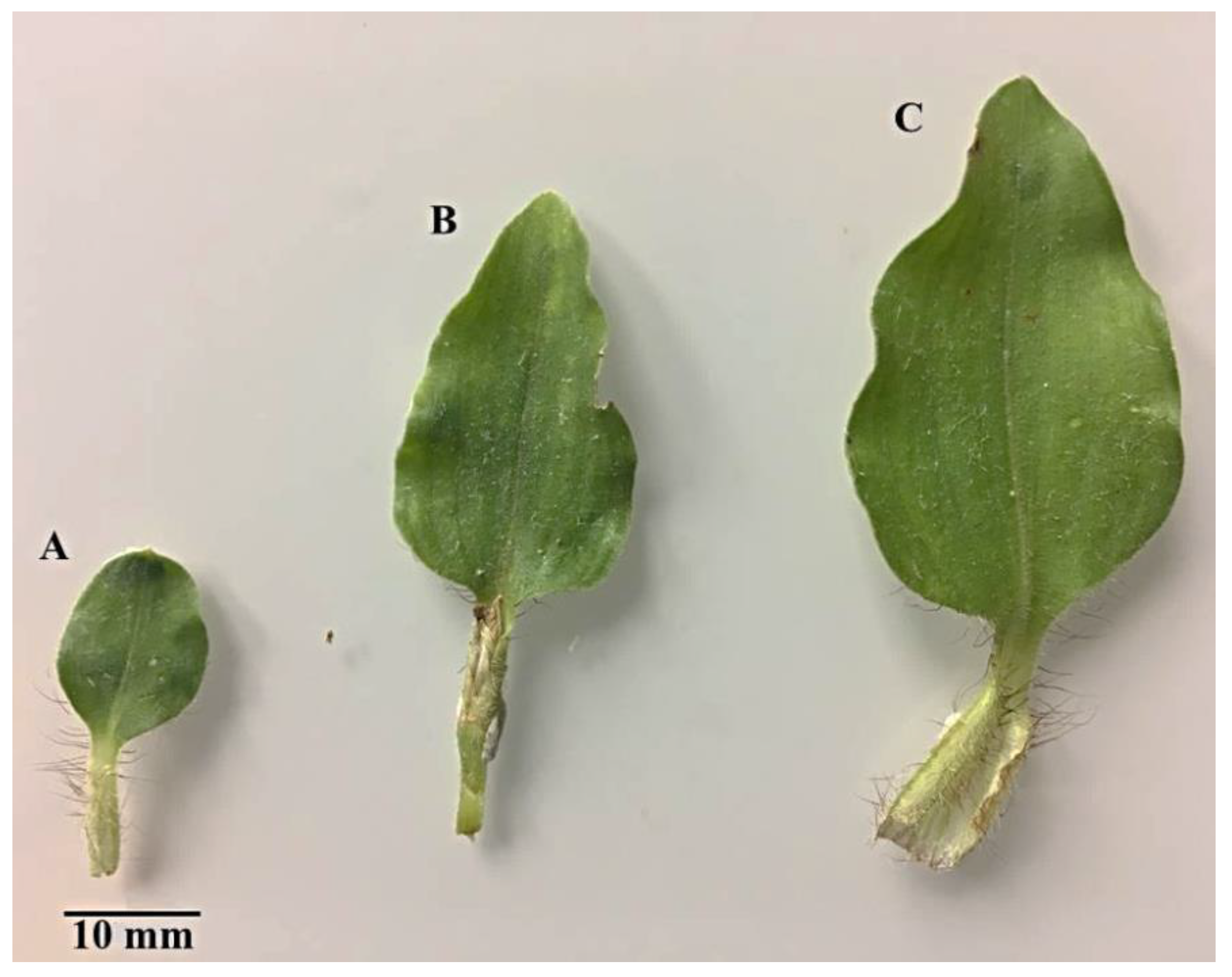
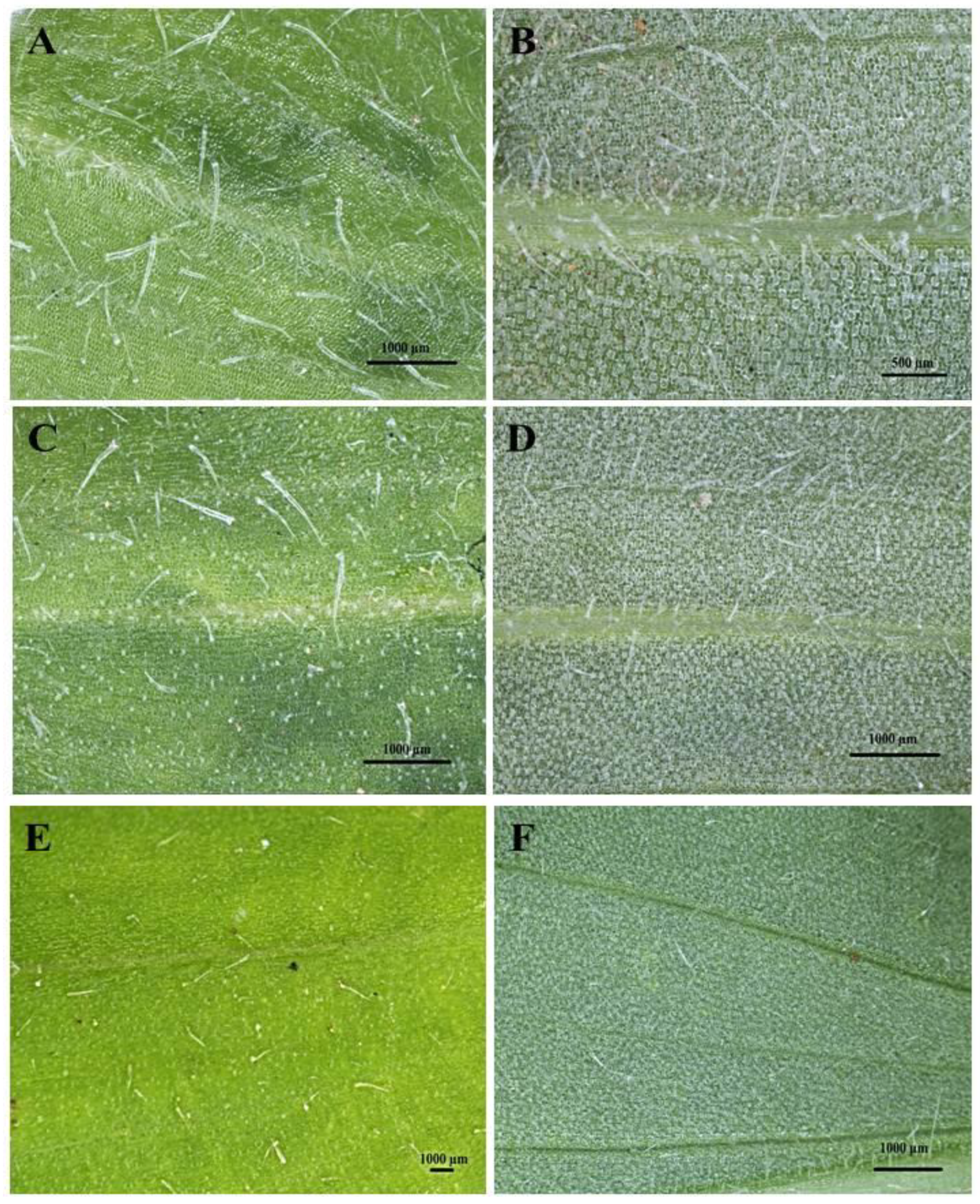
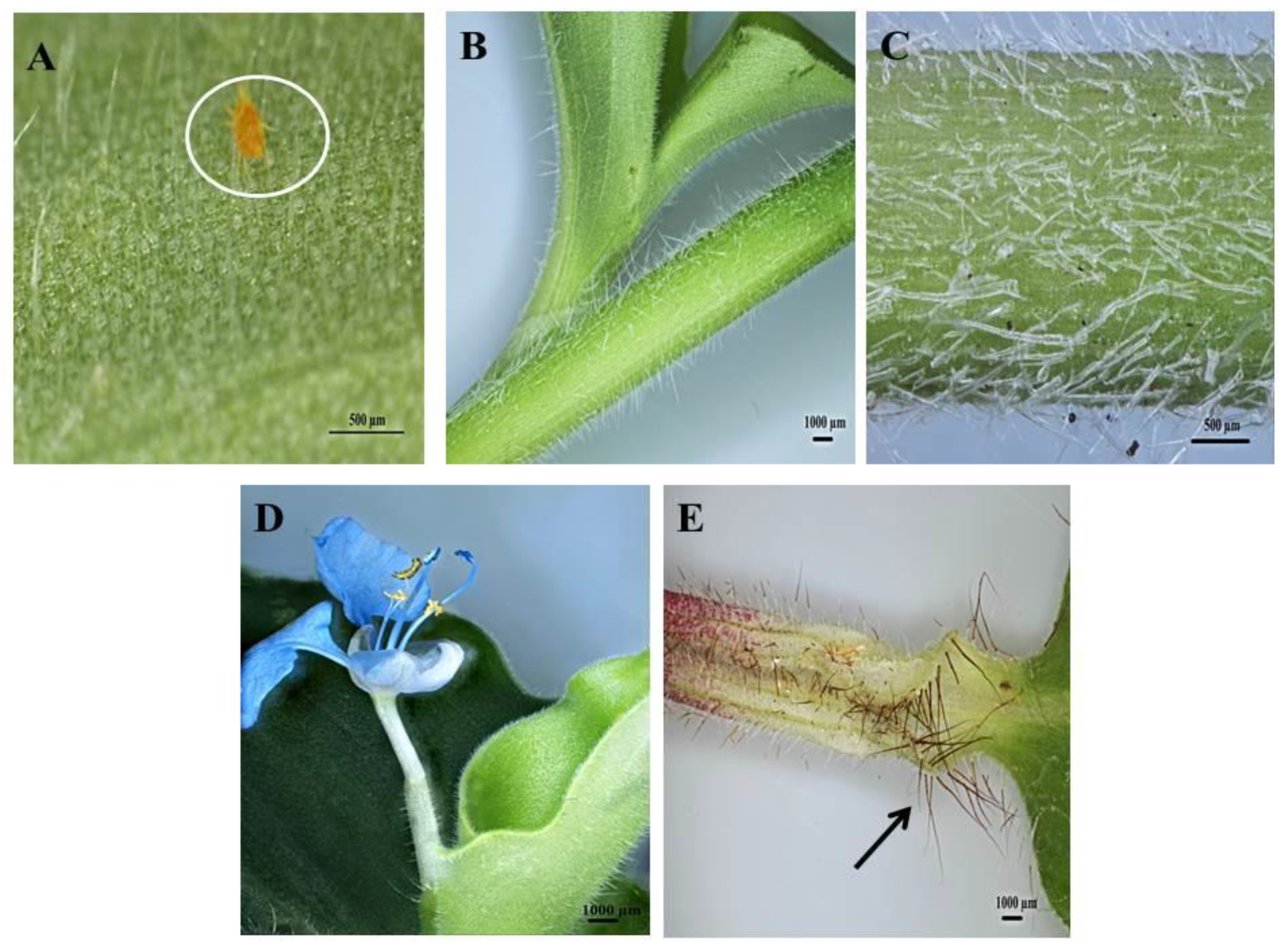
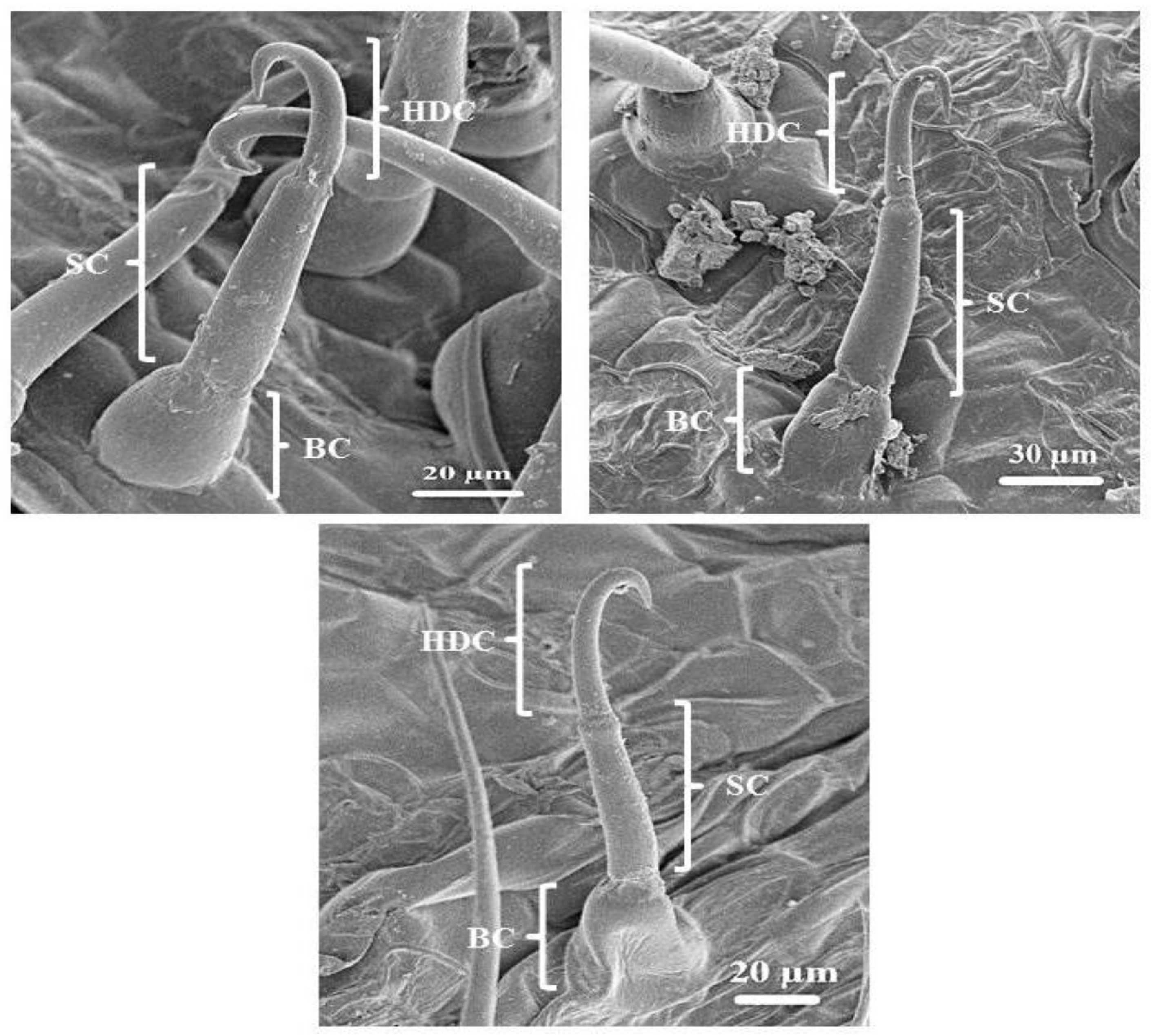
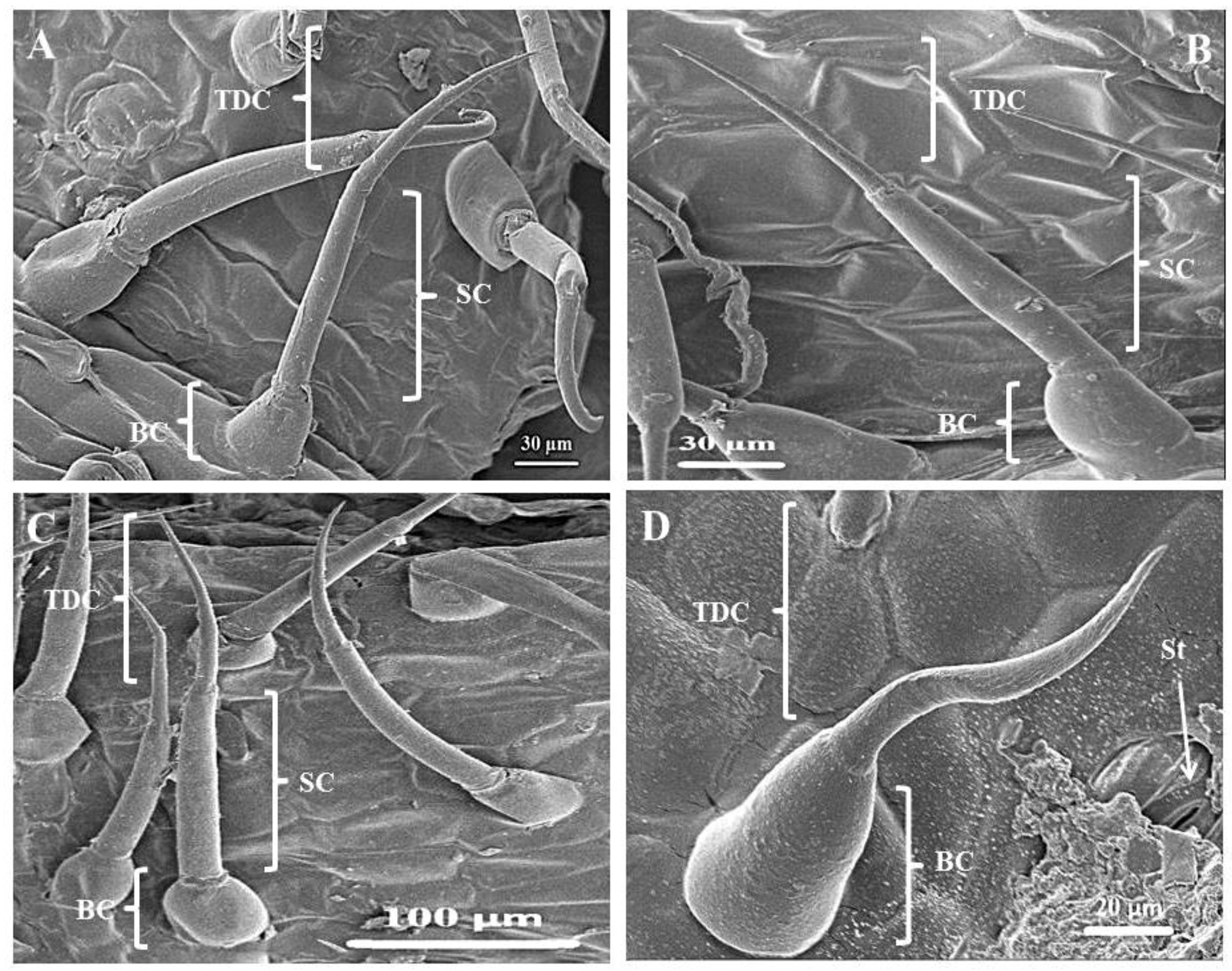
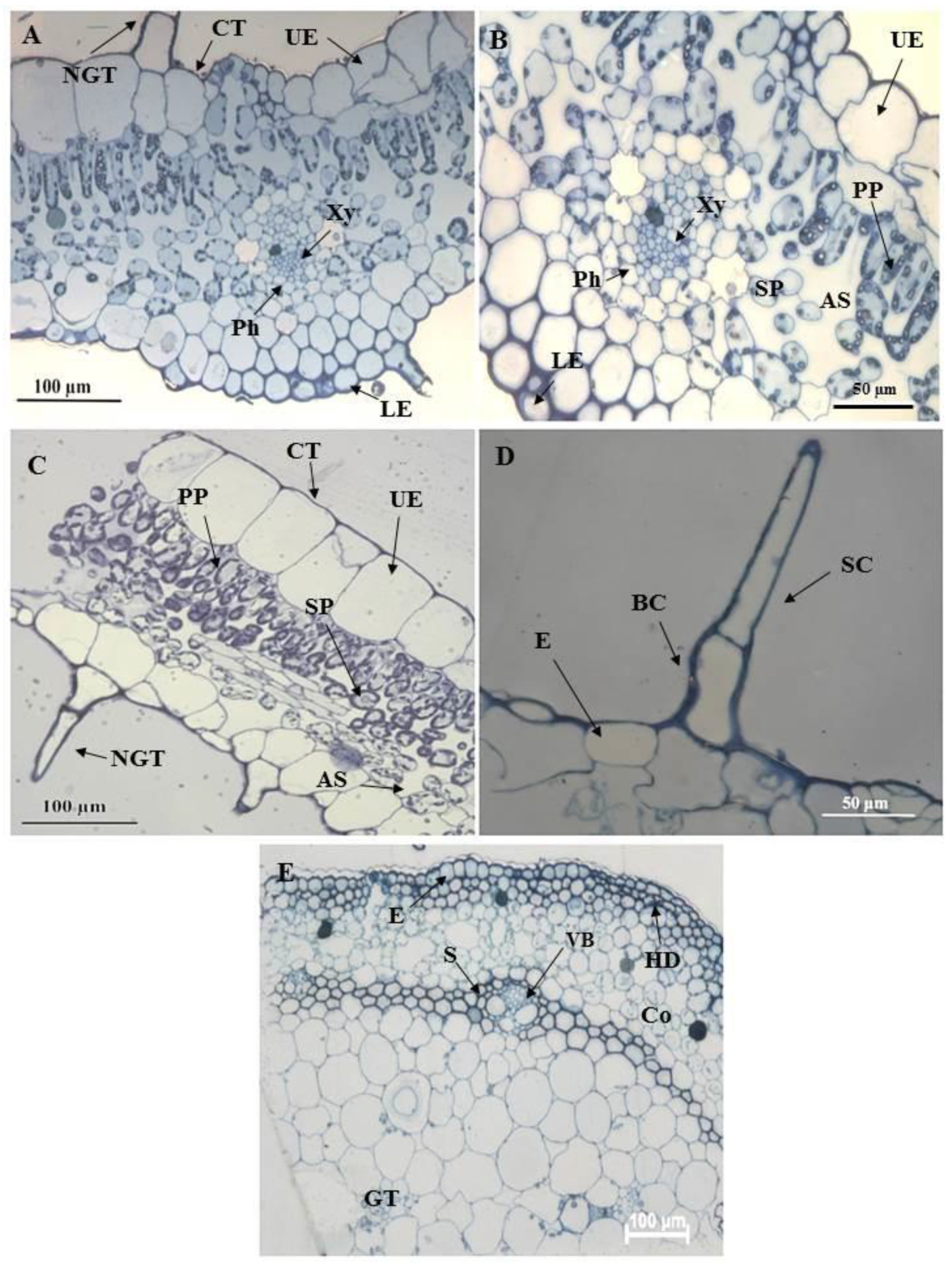
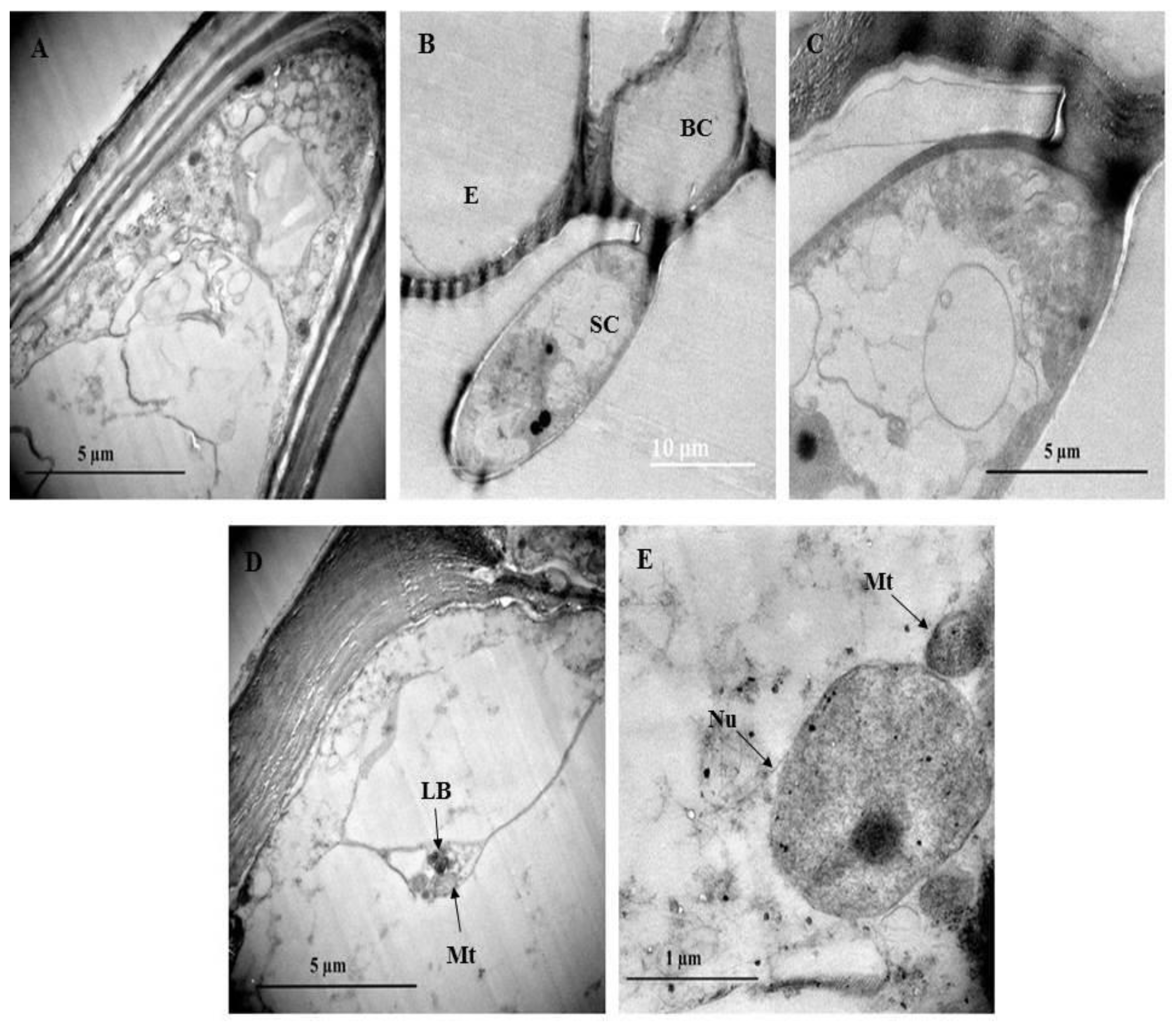
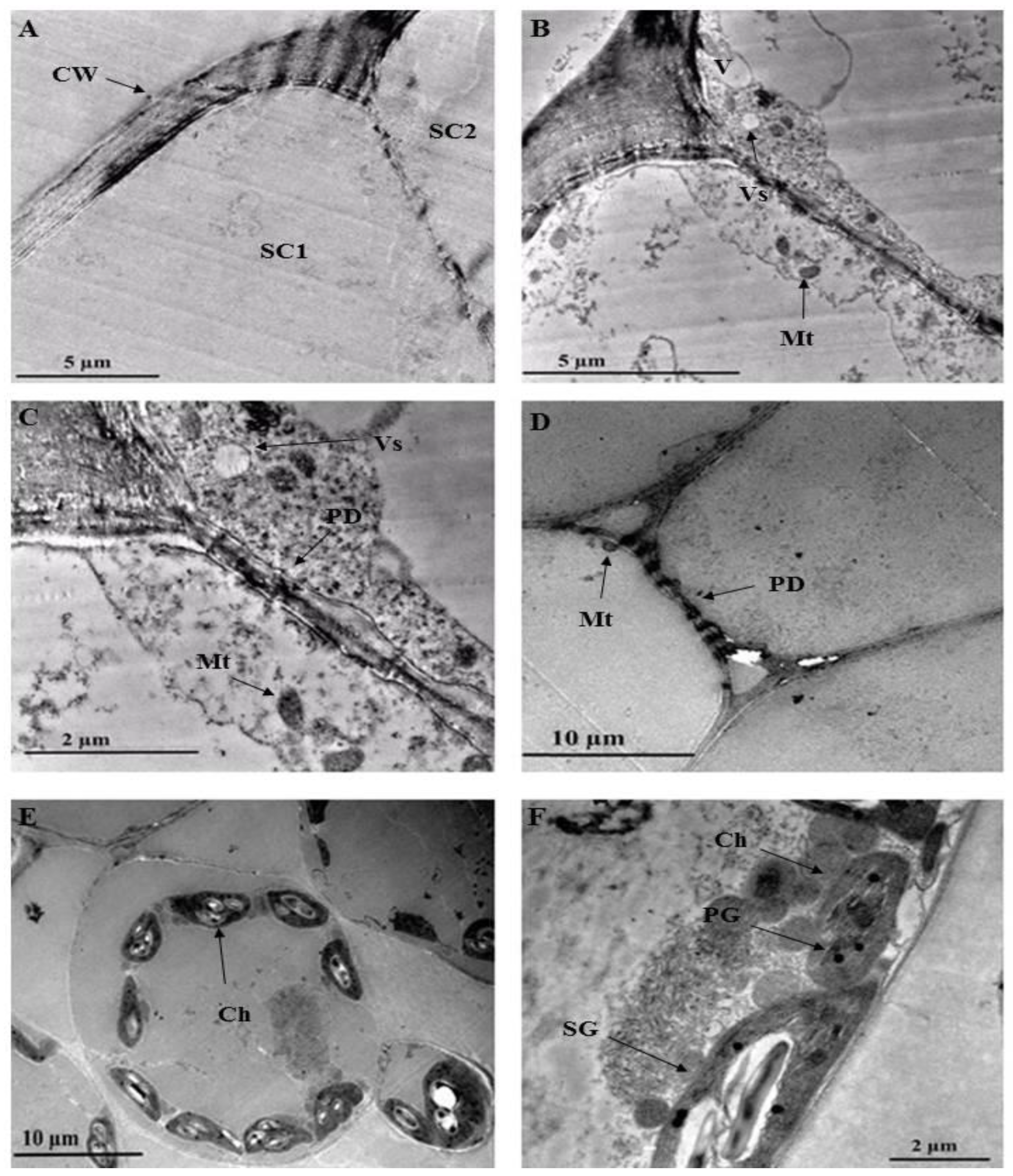

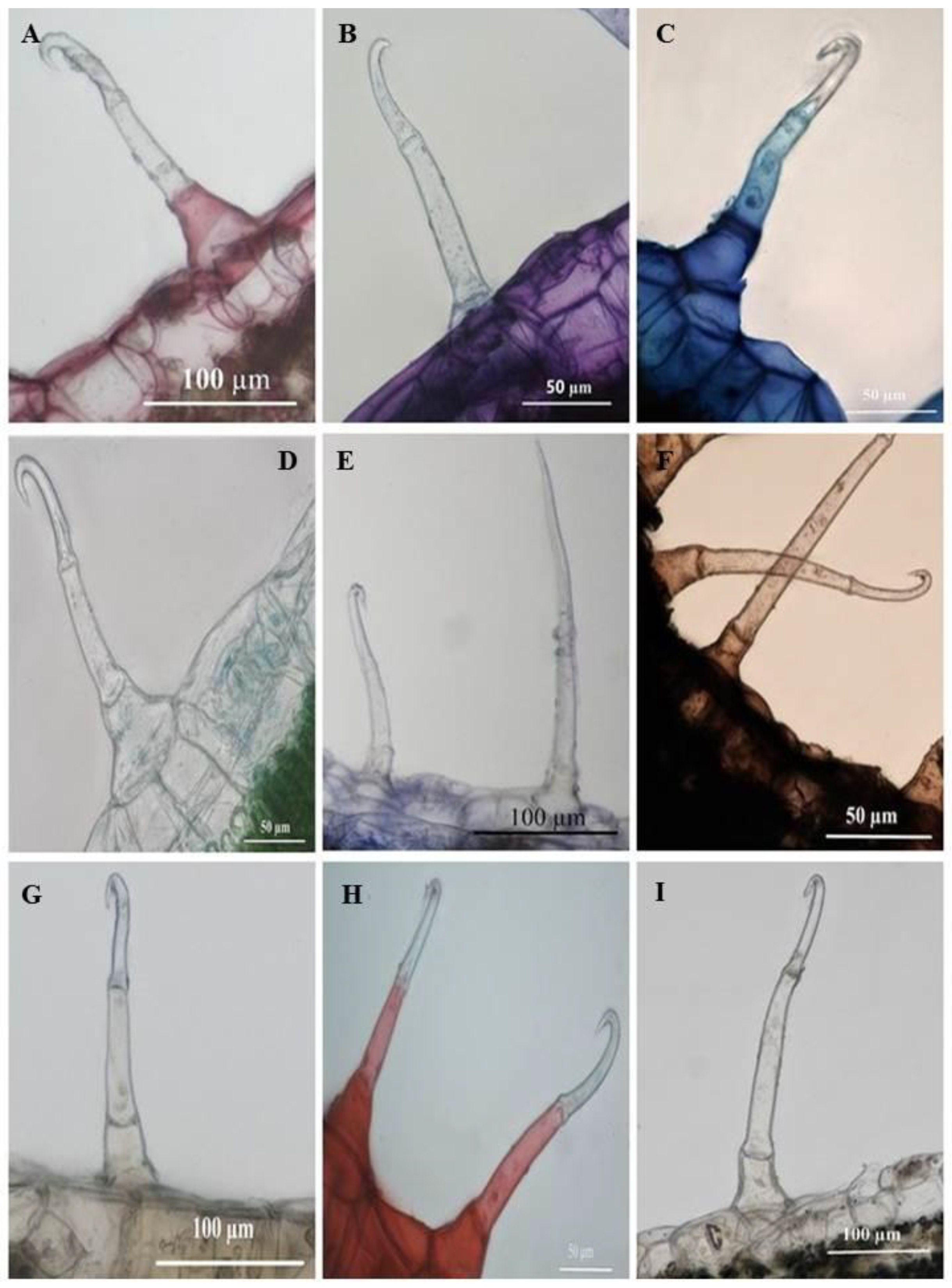
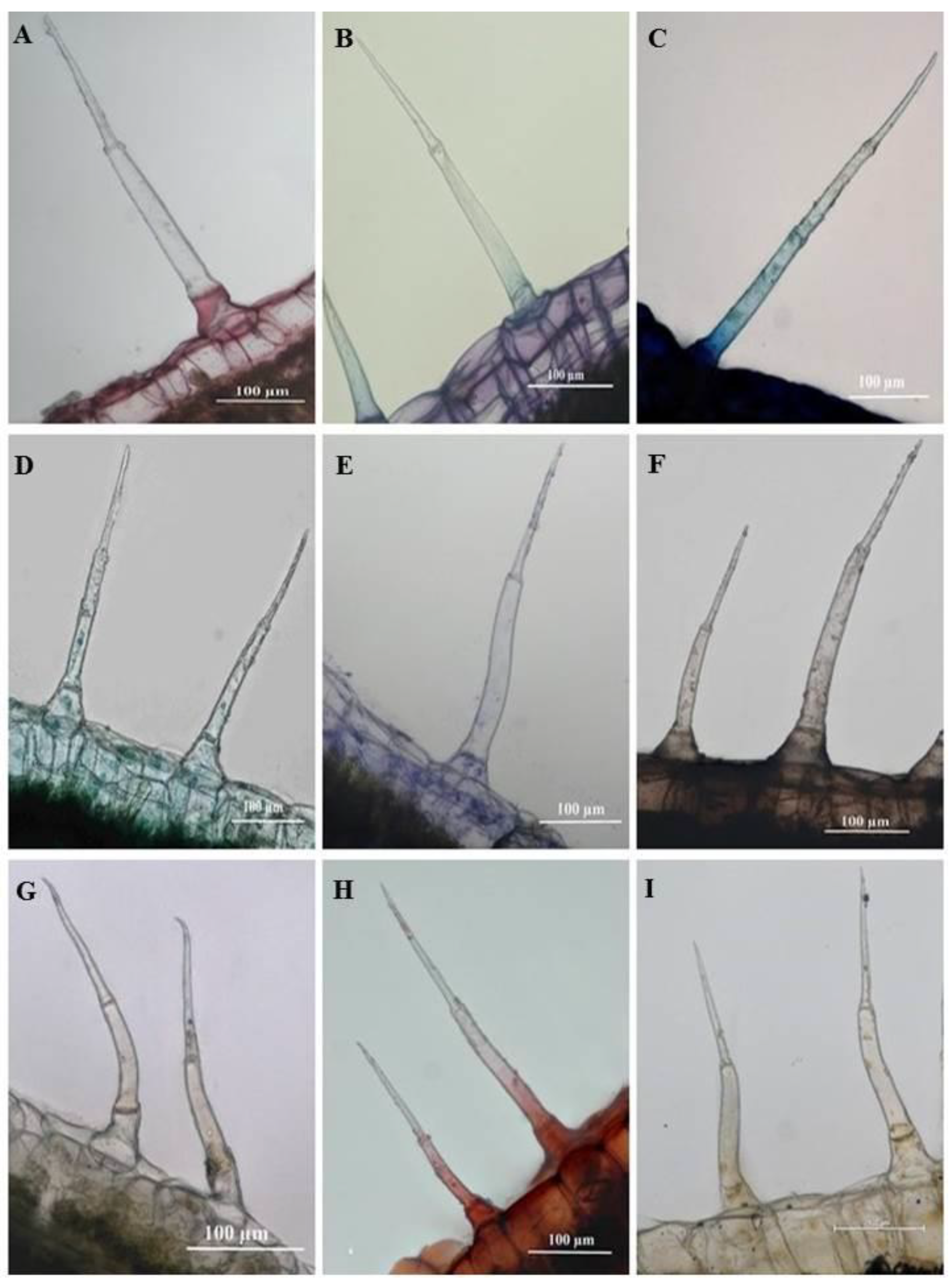
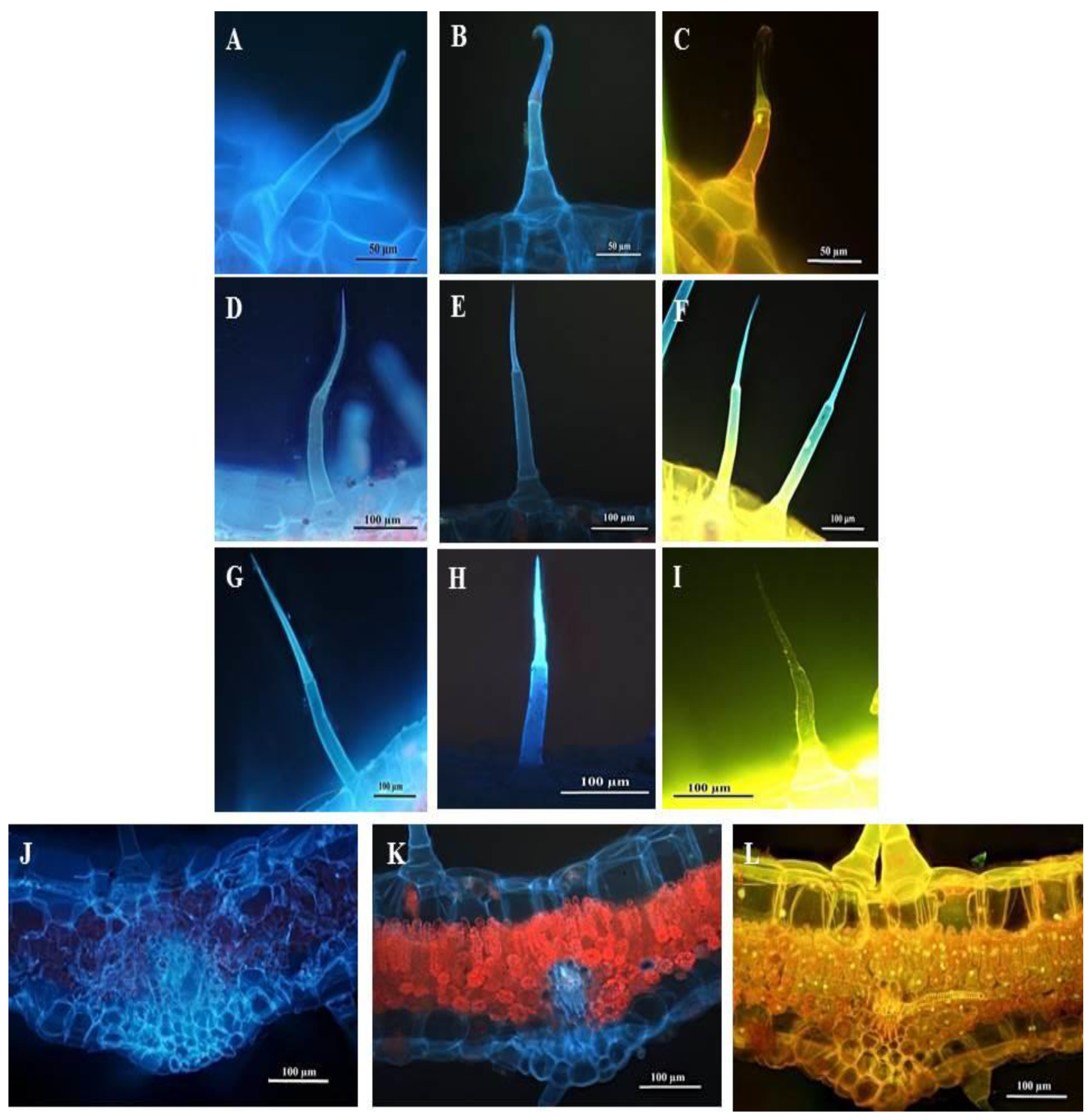
Publisher’s Note: MDPI stays neutral with regard to jurisdictional claims in published maps and institutional affiliations. |
© 2021 by the authors. Licensee MDPI, Basel, Switzerland. This article is an open access article distributed under the terms and conditions of the Creative Commons Attribution (CC BY) license (http://creativecommons.org/licenses/by/4.0/).
Share and Cite
Doolabh, K.; Naidoo, Y.; Dewir, Y.H.; Al-Suhaibani, N. Micromorphology, Ultrastructure and Histochemistry of Commelina benghalensis L. Leaves and Stems. Plants 2021, 10, 512. https://doi.org/10.3390/plants10030512
Doolabh K, Naidoo Y, Dewir YH, Al-Suhaibani N. Micromorphology, Ultrastructure and Histochemistry of Commelina benghalensis L. Leaves and Stems. Plants. 2021; 10(3):512. https://doi.org/10.3390/plants10030512
Chicago/Turabian StyleDoolabh, Kareshma, Yougasphree Naidoo, Yaser Hassan Dewir, and Nasser Al-Suhaibani. 2021. "Micromorphology, Ultrastructure and Histochemistry of Commelina benghalensis L. Leaves and Stems" Plants 10, no. 3: 512. https://doi.org/10.3390/plants10030512
APA StyleDoolabh, K., Naidoo, Y., Dewir, Y. H., & Al-Suhaibani, N. (2021). Micromorphology, Ultrastructure and Histochemistry of Commelina benghalensis L. Leaves and Stems. Plants, 10(3), 512. https://doi.org/10.3390/plants10030512






